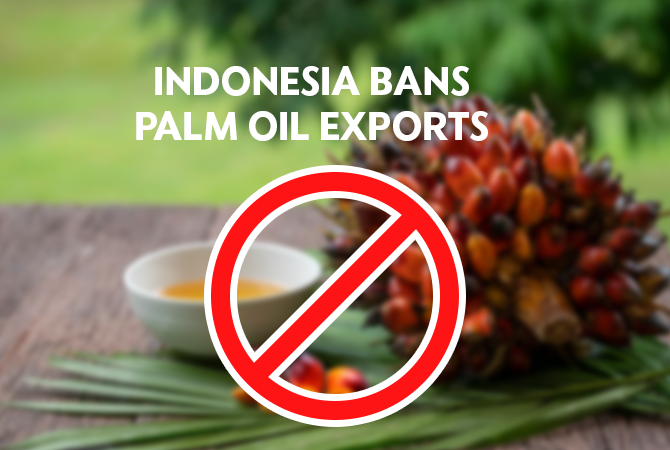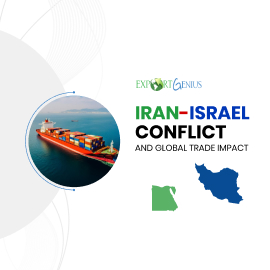Indonesia Bans Palm Oil Exports – Indian Industries will Get Impacted
02 May 2022

Already squeezed by the Russia-Ukraine war, the
world’s supply of cooking oil will be hit hard due to Indonesia’s decision to
ban palm oil exports which will come into effect from April 28. The country decided
in the wake of a local shortage and soaring prices. According to our data
available till Sep, Indonesia shipped US$16.7 billion worth of palm oil to the
world in 2021, among which China (13%) and India (12%) were the biggest buyers.
Here’s a complete overview of Indonesia’s palm oil exports to India and the
world and how it will affect India.
Indonesia’s palm oil exports to
India and the World in 2021
India imports around 8 million tonnes of palm oil
every year, accounting for about 40% of the share in total edible oil
consumption. According to our database, Indonesia supplied US$16.7 billion of
palm oil to the world in 2021 (till Sep data). To India, Indonesia exported
palm oil worth US$2 billion. Below given chart shows the dollar amount of
Indonesia’s palm oil exports to the world and India last year by quarter (till
Sep data).

|
Quarter |
Indonesia Palm Oil
Exports to India (Value US$ Million) |
Indonesia Palm Oil
Exports to the World (Value US$ Million) |
|
2021-Q1 |
624 |
5,790 |
|
2021-Q2 |
481 |
5,573 |
|
2021-Q3 |
939 |
5,369 |
Effect on various industries in
India
Following Indonesia’s ban on palm oil export, the
prices of edible oil and packaged goods in India are likely to see a jump amid
its lower availability in the country. The disruption in supplies can increase
the input costs for companies that are using oil in their products. This can
further stroke the inflation that is already running high at a 17-month high
level.
Indonesia’s ban on the export of palm oil will come
into effect from April 28. The decision was taken in view of the severe
shortage and skyrocketing prices of edible oil in the Southeast Asian nation.
Indonesia is the biggest palm oil producer in the world. Palm oil and its
derivatives are used in food products, biofuels, cosmetics, and detergents.
These are used to manufacture several daily consumption goods such as
chocolates, biscuits, noodles, shampoos, margarine, soaps, and so on. Here are
key highlights of how Indonesia’s ban on palm oil exports would affect various
industries in India.
According to market analysts, due to Russia’s invasion of Ukraine, the world cooking oil supply was already in a huge supply deficit, driving prices of palm and soy oils to record highs.
Palm oil and its derivatives are used in producing several commodities for daily consumption like noodles, biscuits, shampoos, and soaps. This will negatively affect FMCG companies as they use palm oil in their products and any increase in the prices of palm will increase the prices of these commodities as well.
After Indonesia’s ban, domestic edible oil prices are likely to jump 10-15% in the short term.
Russia-Ukraine war has already affected sunflower supplies in India, adding pressure to household budgets.
The second-largest palm oil exporter, Malaysia is also facing a production shortfall due to a pandemic-induced labour shortage and is unlikely to be able to plug the gap.
Industry experts said that Indonesia’s decision affects not only palm oil availability but vegetable oils worldwide. Retail inflation in India jumped to a 17-month high of 6.95% in March 2022, mainly on account of costlier food items. High petrol and diesel prices in the country have already lifted the food and other commodity prices.
Indonesia’s palm oil exports to the
world by the year
Indonesia’s palm oil shipments to the world were
highest in 2017, as per data for the last ten years. In 2020, Indonesia
exported palm oil worth US$17,364 million, which may increase in 2021 as the
country supplied palm oil worth US$16,732 million till September. However,
after announcing the export ban, Indonesia’s exports of palm oil will decline
in 2022. Below given chart shows the dollar amount of Indonesia’s palm oil
exports to the world by year.

|
Year |
Value US$ Million |
|
2012 |
17,602 |
|
2013 |
15,838 |
|
2014 |
17,464 |
|
2015 |
15,385 |
|
2016 |
14,365 |
|
2017 |
18,513 |
|
2018 |
16,527 |
|
2019 |
14,716 |
|
2020 |
17,364 |
|
2021 (Till Sep Data) |
16,732 |
Indonesia’s top palm oil export
partners in 2021
Indonesia is the biggest producer of palm oil, the
world’s most consumed edible oil. Its decision to ban palm oil exports will
send U.S. futures tied to soybean oil, an alternative to palm. In the United
Kingdom, some supermarkets limit cooking oil like sunflower, olive, and
rapeseed.
China and India are the biggest importers of
Indonesian palm oil, together accounting for over 25% in 2021 (till Sep data).
According to Indonesia export data of palm oil 2021 (available till Sep),
Indonesia exported US$2,243 million worth of palm oil to China and US$2,044
worth of palm oil to India. Other buyers of Indonesian palm oil were Pakistan,
the United States, Malaysia, Bangladesh, Spain, Egypt, Myanmar, and Russia.
Below given chart shows the dollar amount and value in percentage of these
countries.

|
Destination Country |
Value US$ Million (Till
Sep Data) |
Value US$ % |
|
China |
2,243 |
13.4 |
|
India |
2,044 |
12.2 |
|
Pakistan |
1,436 |
8.5 |
|
United States |
894 |
5.3 |
|
Malaysia |
831 |
4.9 |
|
Bangladesh |
777 |
4.6 |
|
Spain |
694 |
4.1 |
|
Egypt |
635 |
3.8 |
|
Myanmar |
517 |
3.1 |
|
Russia |
468 |
2.8 |
Russia’s invasion of Ukraine has thrown the trade of
sunflower oil into chaos and is squeezing already tight supplies of other
vegetable oils used in biofuels, food, and personal care products. Now the
global food crisis will further deteriorate from Indonesia’s decision to ban
palm oil exports. The rates of food purchase products in India will further
increase after a rise in petrol and diesel prices.









